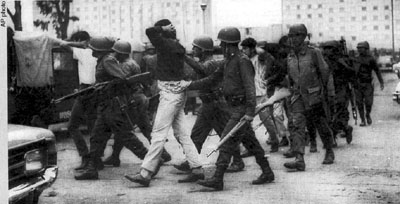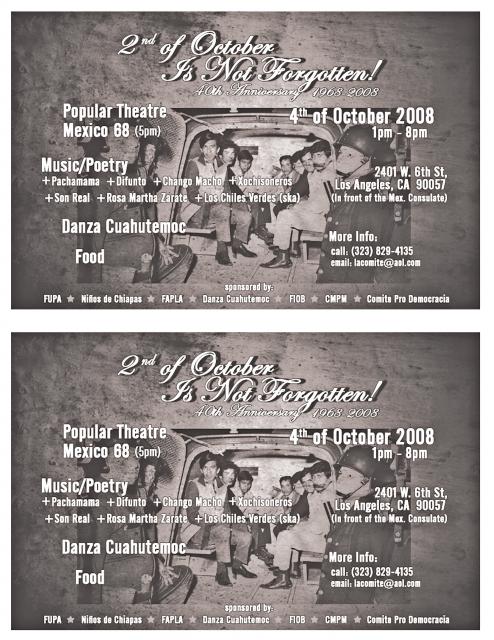Tlatlelolco 1968.
The Olympics were coming to Mexico City. The university students of Mexico who wanted to make a difference in their government, in their country, in their world were on fire with idealism. They papered streets with flyers printed secretly. They marched. They met in houses, coffee shops, and libraries to speak, to plan to try and change the world.
Many were beaten, jailed, tortured. They kept on. Often one or more would disappear and friends and family would go crazy looking. The Mexican government doled out fear and terror, but still the students marched on for change, for peace, for reform. The Mexican Government even launched machine gun fire on a university. Tanks roamed the streets of Mexico City. In September of 1968, the criminal President Diaz Ordaz ordered the Mexican Army to occupy UNAM, the Autonomous University of Mexico that was the country’s biggest university.
Paco Ignacio Taibo, III, one of Mexico’s (and in my opinion the world’s) greatest detective writers was one of them. He painfully and eloquently describes the day-to-day living of the students he worked with leading up to that day in October when Mexico would commit one of its greatest atrocities, in his book ’68. Señor Taibo would be sent to France by his parents just before that day which most probably saved his life.
On October 2, 1968 the students (15,000 strong) had their biggest march ever. They carried red carnations to protest the army’s occupation of the university as they marched on La Plaza de las Tres Culturas at Tlatelolco, Mexico City – a plaza surrounded by apartment buildings, where unbeknownst to the students, Mexican police lie in wait, heavily armed. The students carried flowers. It still makes me cry. I’m crying as I write this thinking of those young, idealists carrying their peaceful red flowers.
About 5,000 of those students, along with spouses and children gathered in La Plaza de las Tres Culturas, chanting. Another 10,000 or so gathered round to watch. The students chanted, “We don’t want Olympics, we want revolution.â€
At sunset, sniper fire opened up on not only the protesting students, but the onlookers as well. Military trucks and tanks moved in. The massacre began. CHILDREN, BABIES were shot. Teenagers were run over by tanks. One of my friends, a fellow danzante who was there told me once in tears, “there were basement apartments and people were literally throwing their babies through those windows of the basement apartments glass and all in order to save them from being shot.†Tears streamed down his face as he spoke of it. He said then, “This once I speak of Tlatelolco and then never ask me again†to the other danzantes in the circle that day. We wept with him.
Once the smoke cleared, the streets ran red with blood and piles of bodies lay in them. The body count is disputed to this day, some people were never accounted for but I believe that the quoted number is over 300. Three hundred people. Three hundred. That’s not counting the wounded or the ones who disappeared. It is believed to have been many, many more.
Many documents remain secret. The American Embassy and the CIA released some. I won’t go into what I think of the American Embassy and government’s knowledge of the event. I will say the massacre was massively covered up in order that the Olympics go on as planned. Streets were cleaned, bodies were buried, and people who would speak out were jailed. A news blackout was ordered and the country welcomed the Olympiads and the world into a smiling, clean Mexico.
My heart aches for those lives lost, for the desaparacidos (the disappeared ones), for what the world lost that sunset in Mexico City, a sunset bathed in the blood of Mexico’s future.
I can only honor them each October 2nd by not forgetting, by letting everyone I know learn of them, keep their memory alive. I recommend books like Paco Taibo’s ’68, Elena Poniatowska’s Massacre in Mexico/La Noche de Tlatelolco. Ms. Poniatowska includes the list of names of the dead; she includes some of the most gut-wrenching photos. These are not easy books to read, but they MUST BE READ. The great poet of Mexico, Octavio Paz talks about Tlatlelolco in his Labyrinth of Solitude: Postdata. He calls for the need to re-write Mexico’s history.
Tlatlelolco was a crime against humanity. It was a crime against the future. It was a crime against freedom, peace and idealism. Tonight at sunset, I will lay one red carnation upon my danzante’s altar near a photo of my uncle and other family that have crossed over to Mictlan. I will light a candle, put on my regalia and take my grandchildren’s hands as we slowly dance the prayer dance Antigua -the prayer dance dedicated to the ancestors. With my grandchildren, I will dance Ofrenda (offering) and Fuego (the fire dance). Lastly, we will dance Chiquita (the dance of the little children). We will bow our foreheads to the edge of the altar as we finish, lay our sonajas and drum down, take off our feathers and and we will read each name from Elena Poniatowska’s list and we will say after each one, “we honor you, we remember you, we will not forget, you live on in our hearts and mind, we will not let the world forget you”. This is our duty, our obligatio as fellow Mexicans, as fellow humans. We remember, we honor.
If you are in the Los Angeles area, I ask you to please consider attending this event in remembrance of Tlatelolco that my dance circle is sponsoring.
Mexica Tiahui







